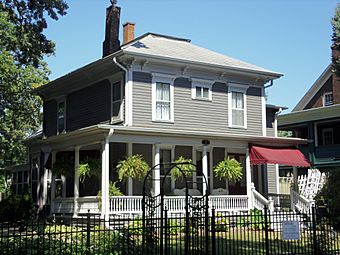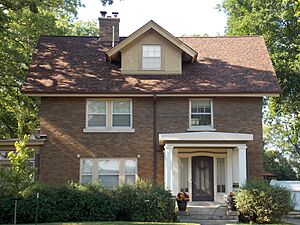Oak Lane Historic District facts for kids
Quick facts for kids |
|
|
Oak Lane Historic District
|
|

Amos Cutter House
|
|
| Location | Oak Lane between High and Locust Streets Davenport, Iowa |
|---|---|
| Area | 7.86 acres (3.18 ha) |
| Built | 1875-1906 |
| Architect | Gustav Hanssen William A. Otis |
| Architectural style | Colonial Revival |
| MPS | Davenport MRA |
| NRHP reference No. | 84000331 |
| Added to NRHP | November 1, 1984 |
The Oak Lane Historic District is a special neighborhood located on the east side of Davenport, Iowa, in the United States. It's a collection of homes that have been recognized as important to history since 1984. That's when it was added to the National Register of Historic Places.
This historic area is a quiet residential street called Oak Lane. It stretches between High Street to the north and East Locust Street to the south. There are 27 houses in the district. Most of them (23) are on Oak Lane itself. Four houses are on Locust Street, right near Oak Lane.
Contents
A Look Back: How Oak Lane Grew
Around 1900 to 1910, a local businessman named Amos Cutter helped create the Oak Lane neighborhood. Before this, the land was mostly used for farming. Oak Lane quickly became known as a place where successful, middle-class families lived.
This area also showed how the city's population was changing. People from different backgrounds were starting to live together. It was less about the old European groups that had settled in the 1800s. Oak Lane also marked the city's growth away from the Mississippi River. This was partly possible because the city's streetcar lines were expanding. Locust Street, on the south side of the neighborhood, was a major streetcar route.
Who Lived Here?
The houses closer to Locust Street are larger and more fancy. They were home to well-off professionals. These included people like William Kellenberger, who managed a printing company. There was also Dr. William Alien, a medical doctor. Horace Roberts was a manager for a company called Gordon-Van Tine. Moritz Landauer owned a clothing store. Martin L. Parker was a leader at a department store. Oscar C. Woods was president of a fruit and produce business.
At the other end of Oak Lane, near High Street, you'll find more modest houses. These were built on smaller pieces of land. Families headed by salesmen, clerks, and factory workers lived in these homes.
Famous Architects
We know of two houses in the district that were designed by famous architects. William A. Otis, an architect from Chicago, designed a Georgian Revival style house at 17 Oak Lane.
Davenport architect Gustav Hanssen designed the Georgian Revival Oscar Woods House at 720 East Locust Street. He might have also designed the nearby Julia Roberts House (726) and the George Johnson House (810). This is because they look similar, but it's not fully confirmed.
Amos Cutter, the developer, later went on to create the McClellan Heights neighborhood starting in 1906. Just like with Oak Lane, he moved into a house in the new area as he sold and developed the other lots.
Architectural Styles of Oak Lane
The houses in the Oak Lane neighborhood show the popular building styles from around the year 1900 in Davenport. This was a time when architecture was changing. People were moving from older Victorian styles, like Queen Anne, to newer Colonial Revival styles.
The three important houses along East Locust Street are great examples of Davenport's Georgian Revival and Federal style homes. The oldest house in the neighborhood is an Italianate style house at 10 Oak Lane. It was built around 1875 and was already on the property when Cutter bought it. This house became Cutter's home while he was developing the area. The newest house in the neighborhood was built at 36 Oak Lane around 1922. It is one of the simpler houses on the north side of the development.






